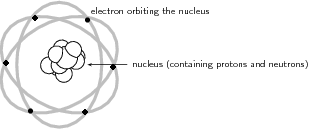| << Chapter < Page | Chapter >> Page > |

The discovery of radiation was the next step along the path to building an accurate picture of atomic structure. In the early twentieth century, Marie Curie and her husband Pierre, discovered that some elements (the radioactive elements) emit particles, which are able to pass through matter in a similar way to X-rays (read more about this in Grade 11). It was Ernest Rutherford who, in 1911, used this discovery to revise the model of the atom.
Rutherford carried out some experiments which led to a change in ideas around the atom. His new model described the atom as a tiny, dense, positively charged core called a nucleus surrounded by lighter, negatively charged electrons. Another way of thinking about this model was that the atom was seen to be like a mini solar system where the electrons orbit the nucleus like planets orbiting around the sun. A simplified picture of this is shown in [link] . This model is sometimes known as the planetary model of the atom.

There were, however, some problems with this model: for example it could not explain the very interesting observation that atoms only emit light at certain wavelengths or frequencies. Niels Bohr solvedthis problem by proposing that the electrons could only orbit the nucleus in certain special orbits at different energy levels around the nucleus. The exact energies of the orbitals in each energy level depends onthe type of atom. Helium for example, has different energy levels to Carbon. If an electron jumps down from a higher energy level to a lower energy level, then light is emitted fromthe atom. The energy of the light emitted is the same as the gap in the energy between the two energy levels. You can read more about this in "Energy quantisation and electron configuration" . The distance between the nucleus and the electron in the lowest energy level of a hydrogen atom is known as the Bohr radius .
Light has the properties of both a particle and a wave! Einstein discovered that light comes in energy packets which are called photons . When an electron in an atom changes energy levels, a photon of light is emitted. This photon has the same energy asthe difference between the two electron energy levels.
Although the most common model of the atom is the Bohr model, scientists have not stopped thinking about other ways to describe atoms. One of the most important contributions to atomic theory (the field of science that looks at atoms) was the development of quantum theory. Schrodinger, Heisenberg, Born and many others have had a role in developing quantum theory. The description of an atom by quantum theory is very complex and is only covered at university level.

Notification Switch
Would you like to follow the 'Siyavula textbooks: grade 10 physical science [caps]' conversation and receive update notifications?